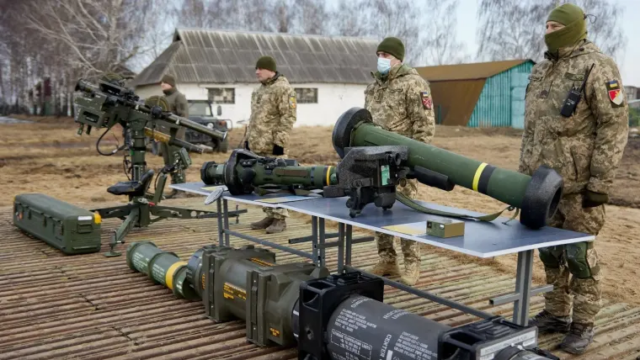
Captured Weapons in Ukraine Pose Windfall for Iranian Defense Industry
Publication: Terrorism Monitor Volume: 21 Issue: 14
By:

As the second year of the high-tempo, artillery-driven Russian war on Ukraine continues, the battlefield has become a huge cemetery both for Western and Russian military assets. However, an opportunity awaits a country like Iran, whose drones over the past few months have been targeting Ukrainian cities. This has provided Russia with a cheap and timely strike package amid its own depleting stocks (see Terrorism Monitor, July 25, 2022).
Like all transactions, Iran’s support for Russia’s ongoing invasion also comes with strings attached. In return for Iranian military support, Russia is allegedly sending sophisticated Western technologies captured on the battlefield to Tehran, including combat-proven assets, such as the Javelin anti-tank missiles and Stinger anti-aircraft systems (Pravda, March 10). Because they provide Iran with sensitive information and insights on Western weapon systems, these fallen arms are of strategic importance for the Iranian regime.
Russia’s potential transfer of the fallen Western weapons to Iran will be a significant boost for Tehran’s military capabilities and its sanctions-crippled defense-technological industrial base (DTIB). From an operational standpoint, increased access to Western technologies will also strengthen Tehran’s hand in the Middle East. Additionally, the Tehran’s access to such systems will also bolster the capabilities and technological know-how of Iranian militias in the Middle East, such as the Lebanese Hezbollah, which are trained and equipped by the IRGC (Twitter/@USAbilAraby, May 14, 2019).
Reverse Engineering: A Key Component of Iran’s DTIB
Since Iran’s ties to the West were abruptly cut off in 1979 with the fall of the Shah, Iran has sought alternative ways to obtain Western military technology to strengthen its indigenous production efforts. A significant share of Iran’s portfolio of reverse-engineered weapons are based on designs of Western systems. For example, one of Tehran’s top military export products, Toophan, is an unlicensed replica of the American anti-tank guided missile (ATGM) BGM-71 TOW. Similarly, the Shahed line is also based on Western designs, such as the US RQ-170 Sentinel reconnaissance drone. The drone in question was captured in December 2011, following a suspicious crash that occurred soon after it entered Iranian airspace (Fararu.com, November 21, 2014).
Besides hunting down critical Western systems in conflict zones, such as Syria and Iraq, Iran has also benefited greatly from Chinese knock-off components of Western systems. Beijing is providing Tehran with designs of critical platforms, which helps to drive the Iranian DTIB forward, despite the Western sanctions. The engines used in Iranian loitering munitions seen in Ukraine were built in China, and are a direct copy of a German product (Institute for Science and International Security, October 21, 2022). This particular example illustrates the intertwined nature of the Chinese–Iranian military partnership, as well as the role of Beijing’s military transactions with the West as the driver behind Iran’s DTIB.
Ukraine Presents New Opportunities for Tehran and its Proxies
Historically, numerous Western military systems have ended up in the possession of Iran, which has taken hold of hundreds of American arms from conflict zones. Iranian forces conducted four significant thefts worth $200,000 dollars in Iraq and Syria between 2020 and 2022. While not all captured systems were disclosed, the thefts included high-destruction military assets, such as 40 mm high-explosive grenades, used by US Special Forces (Pars Today, April 1).
Now, the Ukrainian battlefield presents similar risks. Russia already began cargo flights carrying stolen military equipment from Ukraine as early as the summer of 2022. According to US allegations—which were also echoed in Russian media outlets—Moscow flew $141 million in cash and various Western military assets (a British NLAW, a US Javelin ATGM, and a Stinger anti-aircraft missile) to Iran in return for 160 Iranian UAVs (The Moscow Times, November 9, 2022). Official US documents state that the Raytheon and Lockheed Martin-made system is able to penetrate all known armor, “well in excess of 30 inches of rolled homogenous steel” (US Marine Corps, 2015).
Therefore, if captured or even successfully reverse-engineered, Iran can challenge the US in its own game. This risk is even more imminent at a time when Iranian proxies are scaling up their attacks against US forces in hot zones, such as Syria (Aftabnews.ir, March 24). In the current tense international situation, access to such systems provides Tehran’s proxies with improved warfighting and striking capabilities, and places US troops and platforms at heightened risk.
Conclusion
Beijing, a leader in field of reverse-engineering, might soon enter this game as well. Hand-in-hand, the Russian–Chinese duo can offer significant military-strategic advantages to Iran. At present, Western weapons-related exports to China are severely restricted. However, some military contractors and dual-use technology producers are still engaging in business with Beijing—especially in important critical sectors, such as the aerospace industry.
A successful reverse-engineering process is heavily dependent on the availability and sustainability of subcomponents. Whether or not Iran’s technological base is sufficient to produce the subcomponents of such technologies indigenously remains to be seen. In theory at this point, Russia, or the “tech giant” China, might be willing to lend Iran support. Therefore, in the near future, the West will need to closely monitor trade activities in the Russian-Iranian-Chinese triad.



